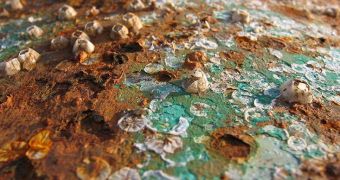Researchers have recently identified a chemical that could soon make barnacle contamination of ship hulls a thing of the past. The finding was been a long time coming, and it arrives not a moment too soon.
Even the US Navy has bee investigating methods of getting rid of the pesky marine life forms for years, but with little luck, AlphaGalileo reports.
Barnacles can affix themselves to the hulls of ships, producing a phenomenon that is widely known as biofouling. Colonies growing on ships have numerous negative consequences.
The most important one is the fact that the ship's drag is increased, which means that it consumes a lot more fuel in order to travel the same given distance.
They also make it more difficult for ships to cut through waves, which is a severe issue all in itself.
For years, experts have been using the substance called medetomidine to get rid of the barnacle colonies, but some of the organisms proved to be very resilient to the chemical's effects.
Now, a team of investigators from the University of Gothenburg believe they may have identified a gene that makes the barnacles responsive to the effects of medetomidine.
The finding could lead to the development of new chemicals, that would increase the organisms' sensitivity to the toxic agent. Large ships could benefit from this discovery extensively.
The research team believes that its findings could lead to the development of an advanced type of antifouling paint, one that is gentle both to the barnacles and to the environment.
At this point, getting rid of the troublesome creatures involves the ship being taken our of the water in a construction yard, or having divers perform complex maneuvers underwater, potentially endangering their own lives.
“We have found that medetomidine activates special receptors in barnacle larvae. The receptors emit a signal that causes the larva to swim away from the boat surface, instead of attaching to it,” explains Anders Blomberg.
“As the receptors are already activated at very low concentrations of the substance, this means that very low levels are also needed to be effective,” adds the expert, who is a professor at the UG Department of Cell and Molecular Biology.
“Understanding how the substance works when it binds to the receptor also makes it possible to develop selective agents that only affect barnacles and not other marine organisms,” the expert says.

 14 DAY TRIAL //
14 DAY TRIAL //